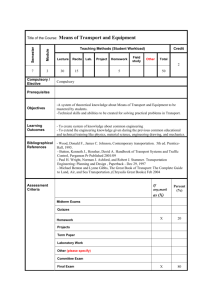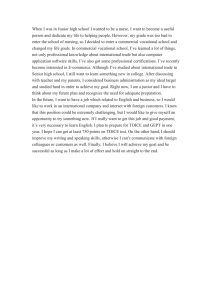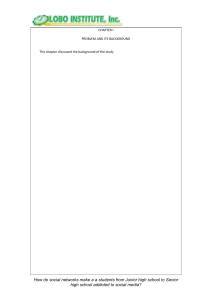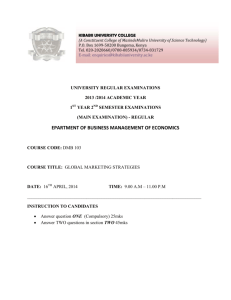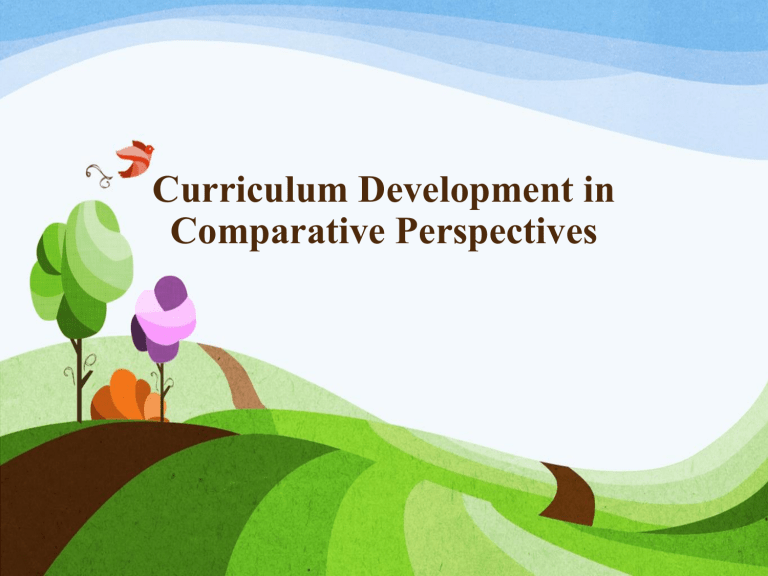
Curriculum Development in Comparative Perspectives China • Most populous country of the world is China • 200 million students attending public schools taught by over 9 million teachers in the elementary, junior, and senior high schools • largest educational system of the world • The course syllabi are written by scientists and professors hired by the National Educational Commission. • Education in China is a state-run system of public education run by the Ministry of Education. • NINE YEAR COMPULSORY EDUCATION(1986) • 6 Years of Primary Education • 3 Years of Junior Secondary Education Education in China is divided into four categories • basic education • secondary vocational-technical education • regular higher education • adult education. • Education is free and compulsory for 9 years in China, split between Primary and Junior middle school at the age of 6-15. many children start their schooling at a nursery school (called Kindergarten in China) as early as 2 years old. • 2-6: Kindergarten • 6-12: Primary school (compulsory) • 12-15: Junior middle school (compulsory) • 15-18: Senior high school (middle school) or Vocational school • 18-22: University or college • Secondary vocational training provide short-term vocational programs of finance and economics, physical education, and arts. • Technical training provide medium-level skilled workers, farmers, as well as managerial and technical personnel. • Both have 3 or 4 years programs PRIMARY EDUCATION • Age: 6-12 Years • • Duration: 5-6 Years • • Compulsory Subjects: • Moral Education, Chinese Language, • Mathematics, Social Studies, Natural Science, • Physical Education, Music, Arts, and Labor • Services. SECONDARY EDUCATION • Junior Secondary Education • Duration:3-4 Years • Compulsory 13 Subjects: Politics, Chinese Language, Mathematics, Foreign Language, History, Geography, Physics, Chemistry, Biology, Physical Education, Music, Art, and Household Skills. China • 1993: syllabi and twenty‐four curricula for nine‐year compulsory • programme • 1998: adjustment of primary and secondary school curriculum • contents; reducing the overload and subject difficulty; enabling locally • relevant selection of teaching materials • 2001: implementation of curriculum standards for basic education; • emphasizing innovation and creative thinking India • 1988: National Curriculum Framework for Elementary and Secondary Education • 2000: National Curriculum Framework; emphasizing minimum levels of learning, values, ICT, management and accountability, continuous comprehensive evaluation in cognitive, social and value dimensions. • 2005: shift in examination system from content‐based testing to problem‐solving and competency based assessment; states encouraged to renew their own curriculum in light of the national curriculum framework • Curriculum no longer to be bookish but was to be drawn from the social and physical environment of the child. In fact, the system offered a larger measure of freedom to teachers at a time when they were not prepared to shoulder it. • Courses of study, therefore, in history, geography, economies, civics were fused together and were called social studies. • Similar courses in physics, chemistry and biology were fused together and called general science. All books were rewritten and the teacher training institutions began to advocate this integrated approach Indonesia • 1999: development of a national competency based curriculum allowing both unity and diversity; addressing overload and overly rigid curricula • 2006: application of school based curriculum Malaysia • 1983, 1995, 1999: content and outcome based curriculum; use of activity based and student centred pedagogy approaches; promoting critical and creative thinking skills • 2008: trial implementation of new modular and thematic curriculum and school based assessment • 2011: implementation of the standard curriculum for primary school in Stage/Phase I (grades 1‐3) building on the Integrated Curriculum for Primary School introduced in the late 1990s. • The main aim of science at the primary level is to lay the foundation for building a society that is culturally scientific and technological, caring, dynamic and progressive. • Emphasis is given on the mastery of scientific skills needed to study and understand the world. Scientific skills refer to process skills and manipulative skills. At the lower primary level, elements of science are integrated across the curriculum. New Zealand • 1992: Outcomes focused curriculum • 2007: New Zealand Curriculum (NZC) consisting of a framework of key competencies integrating essential skills, knowledge, attitudes, and values. PAKISTAN Phases • Evolution of curriculum objectives. • Development of scheme of studies. • Development of syllabus of each subject. • Development of textbook, instructional Material. • Approval of textual material. • Teacher training. THE SCHEME OF STUDIES It is based on three key factors: • The national education policy • Market demand • Global issues Visit National Curriculum 2006 USA • Schooling compulsory 5-16 • Curriculum state wise different • Local autonomy and pluralistic nature • No official state curriculum • Stakeholders involved in curriculum development • English, mathematics, social studies, music, arts, physical education. • Advancement in new technology-new teaching methods • High school diploma require attendance and satisfactory school record UK • National curriculum • Core three subjects: maths, science, languages • Provision of religious education also included • Nation wide assessment at terminal stages Canada • No national curriculum • 12 provinces…12 education systems…stemming from aspirations of the people of that community • Discovery method Russia • Continuously updating since 1920 • State controlled education system • Primary: games, study, entertainment, all aspects of physical, moral, academic education • Secondary level: vocational and specialized secondary schools • Labour education throughout secondary education • Higher education accessible to everyone Japan • Overall development of learner • Primary : activities, basics of arithmetic, read and write • Japanese languages, science, Maths, handicrafts, physical education • Pre-vocational, English as foreign language Thanks

